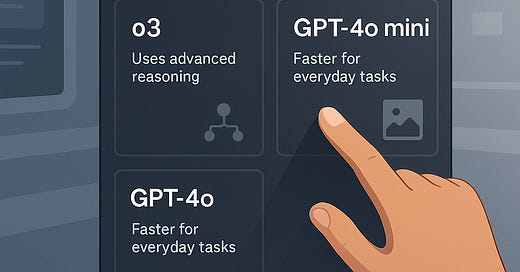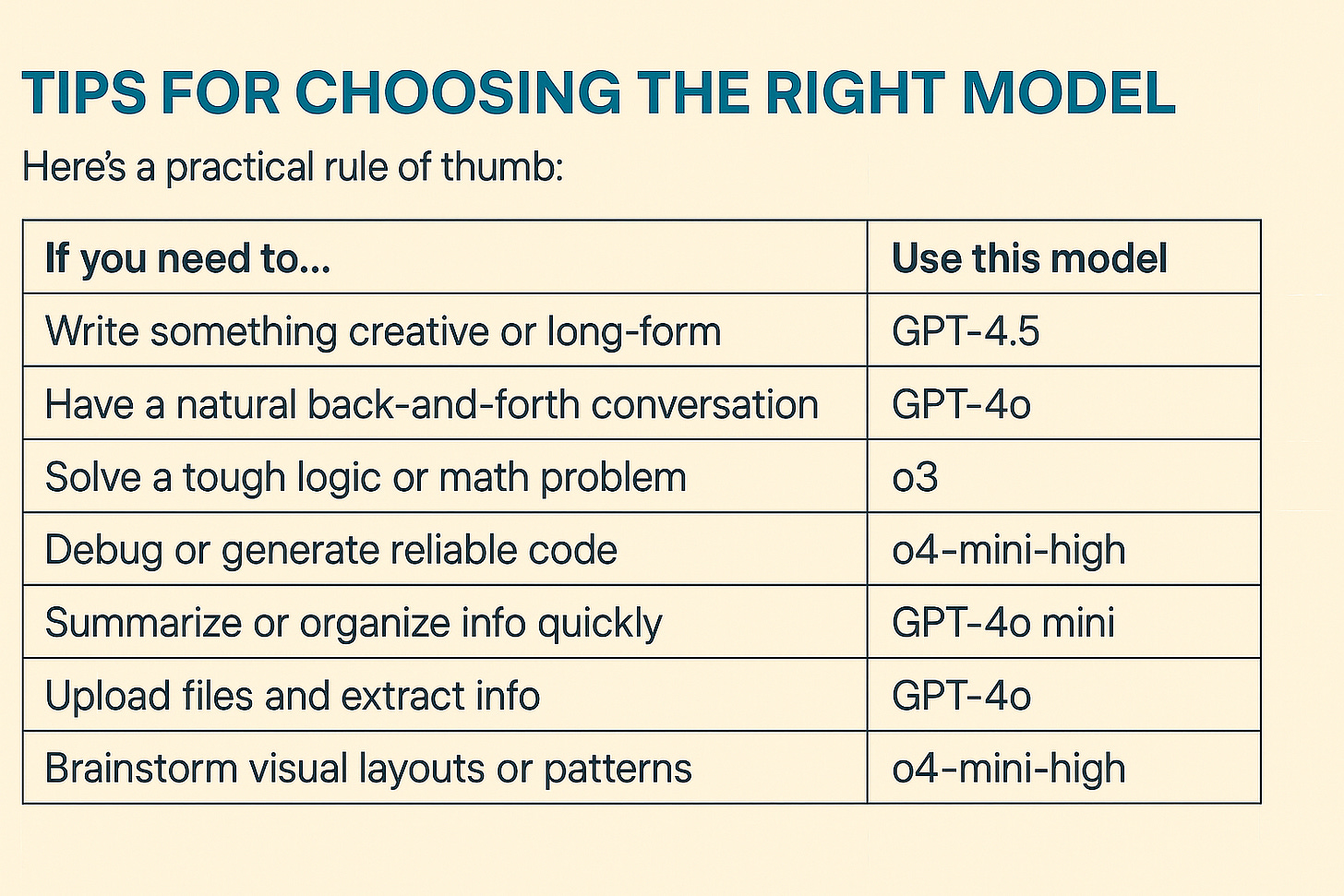If you've opened the ChatGPT app recently, you might have noticed something new: a growing list of available models like GPT-4o, GPT-4.5, o3, and a handful of mini variants. Sound confusing? Well, it is confusing a lot of people.
The good news? Open AI has made their most powerful tools more accessible than ever. The confusing part? Figuring out which model to pick and when to do it.
This post breaks it all down in plain English to help you whether you're using ChatGPT for school, work, writing, coding, or just day-to-day tasks.
What Models Are Available Right Now?
As of May 2025, these are the ChatGPT models you can switch between (depending on your plan and access level):
What’s the Difference Between Reasoning and General-Purpose Models?
This is where many users get tripped up—because not all models are built for the same kind of thinking.
General-Purpose Models
These are models like GPT-4o, GPT-4.5, and GPT-4o mini. They’re built to handle a wide range of tasks: writing, conversation, basic logic, summaries, language translation, and general help.
They’re trained for flexibility. Think of these as your "Swiss Army knife" models. They do a little of everything and usually sound the most natural when writing.
Use them when:
You’re chatting, asking questions, or brainstorming
You’re writing articles, essays, or social media content
You need to work with images, files, or documents
Reasoning Models
Models like o3, o4-mini, and o4-mini-high are designed for focused, logical thinking.
They shine when:
You’re solving step-by-step problems
You need math to be precise
You're writing or debugging code
You're analyzing structured data or complex rules
These models are less “chatty” and more “deliberate.” They may not be as good at storytelling or conversational writing. But if you want pure reasoning strength, they're your go-to models.
Model Breakdown: What to Use and When
GPT-4o
"Great for most tasks"
This is your all-around model. It's fast, smart, and works with text, images, and audio. It handles most writing, editing, brainstorming, and visual input with ease.
Good for:
General writing and editing
Summarizing PDFs or web content
Analyzing uploaded documents
Light coding help
Answering "how do I…" questions
Voice input/output (on mobile)
GPT-4.5 (Research Preview)
"Good for writing and exploring ideas"
This one's experimental. Open AI is testing improved reasoning and creativity here. Expect slight quirks, but also some standout moments in how it handles tone and structure.
Good for:
Brainstorming story ideas
Writing long-form content
Playing with creative or opinionated tone
Thinking out loud with style
o3
"Uses advanced reasoning"
This is a heavy-duty logic engine. It’s less about sounding friendly and more about giving you the right answer—especially in tasks that require planning, analysis, or layered thinking.
Good for:
Technical breakdowns
Math explanations
Decision-making workflows
Formal logic or structured problem-solving
o4-mini
"Fastest at advanced reasoning"
A lighter, quicker version of o3. This model balances logic and speed, and is great for complex requests that don’t need the full weight of o3’s deliberate thinking.
Good for:
Solving multi-step problems
Explaining technical concepts quickly
Quick turnarounds on logic-heavy requests
o4-mini-high
"Great at coding and visual reasoning"
This is the best pick if you're a developer or dealing with structured formats like JSON, charts, or layouts. It’s fast, code-literate, and visual-aware.
Good for:
Writing and debugging code
Understanding data schemas
Visual comparisons or spatial layouts
Explaining code behavior clearly
GPT-4o mini
"Faster for everyday tasks"
This model gives you speed over depth. It's perfect when you just want to get a quick summary, list, or idea. Not ideal for logic-heavy tasks, but perfect for casual usage.
Good for:
To-do lists
Rewriting text quickly
Simple summaries
Casual, fast conversation
Tips for Choosing the Right Model
Parting Advice: Don’t Overthink It
The great news? You can’t really “break” anything by choosing the wrong model. All of them are built to handle everyday requests, and switching between them is instant.
Start with GPT-4o. It’s well-rounded, intuitive, and handles most of what people need.
If you hit a wall, then maybe the model is struggling with logic, or the code isn’t working right. If that appears to be the case, try a reasoning model like o3 or o4-mini-high.
If you're writing something long or trying to break past creative blocks, test-drive GPT-4.5 and see what it gives you.
Bonus Tip: Think Like a Director, Not a Programmer
Each model is like an actor with a slightly different skillset. Your job is to give clear direction, not to micromanage the script. A well-written prompt goes a long way regardless of which model you’re using.









Nice guide! Since I have the Pro subscription, I find myself using o3 for many tasks, unless I'm in a hurry.